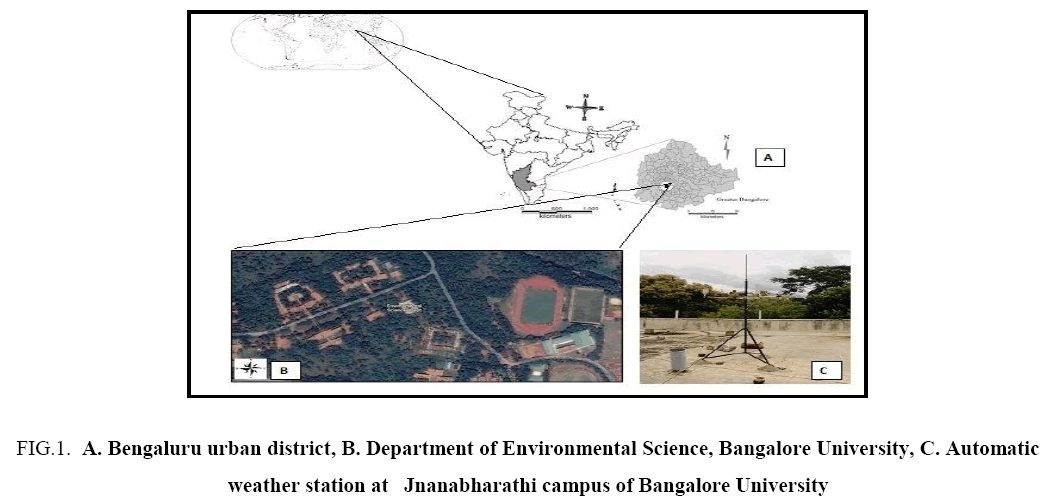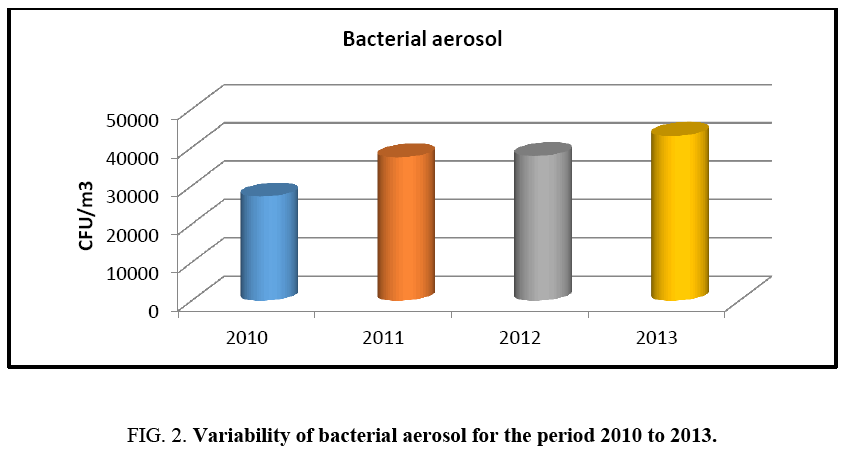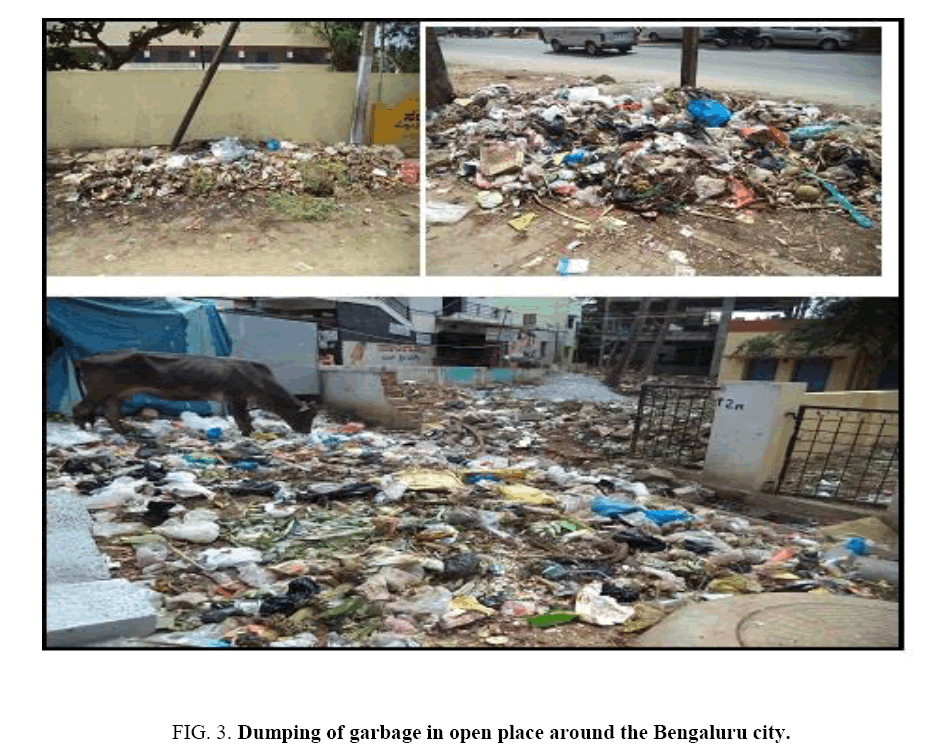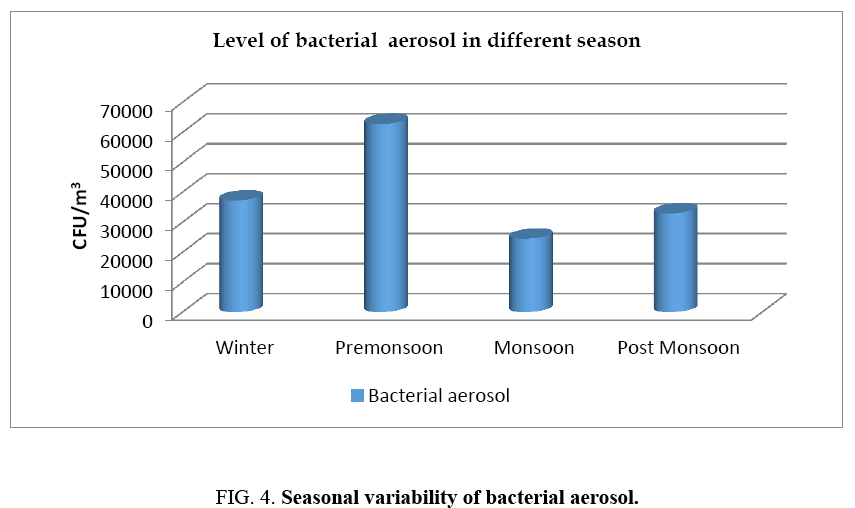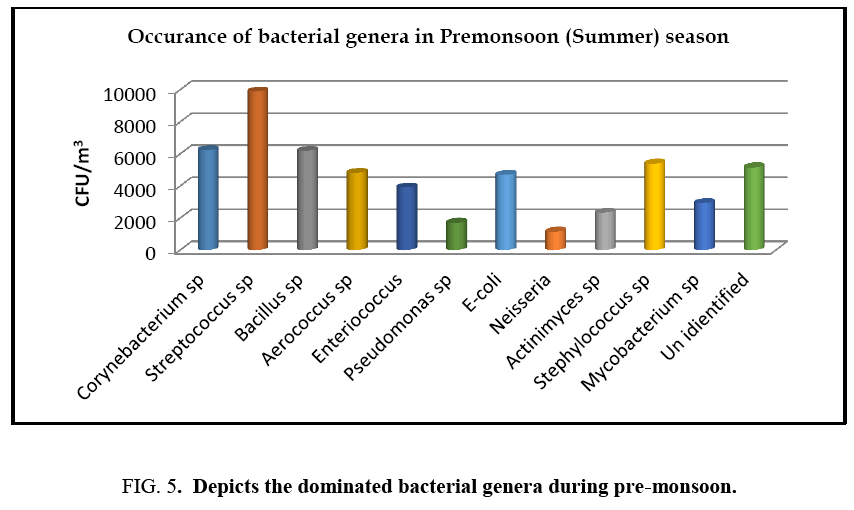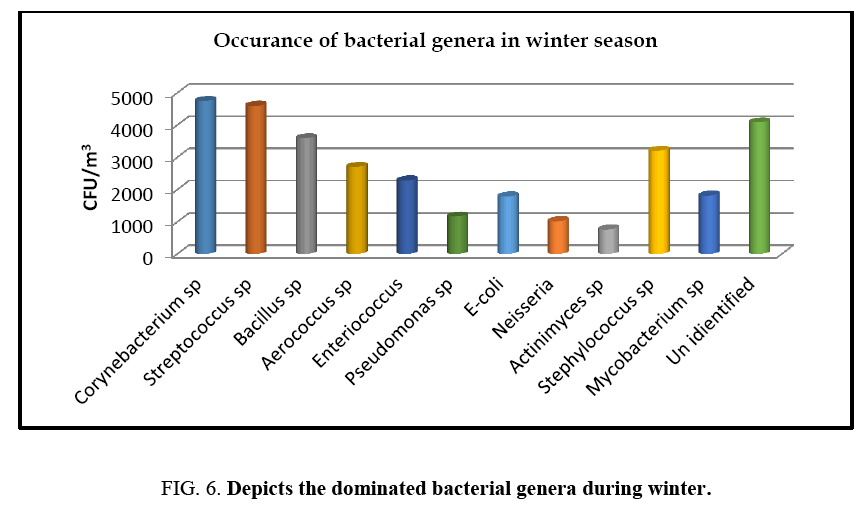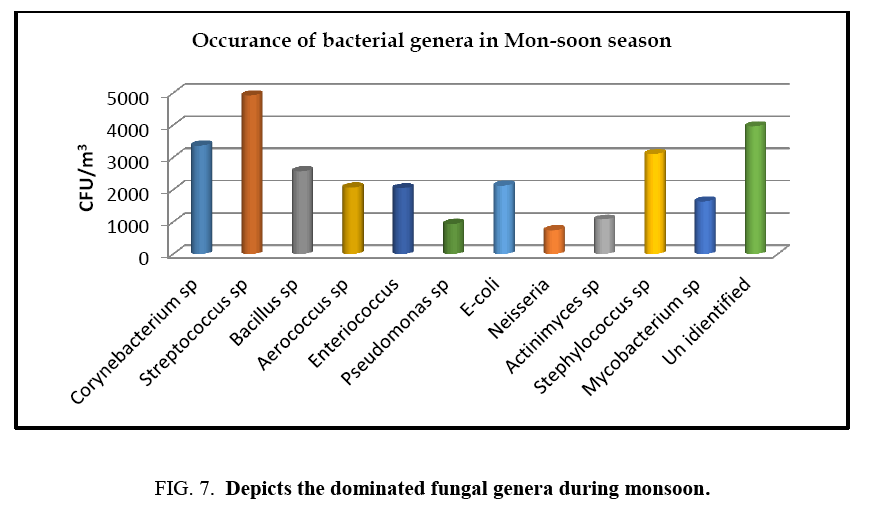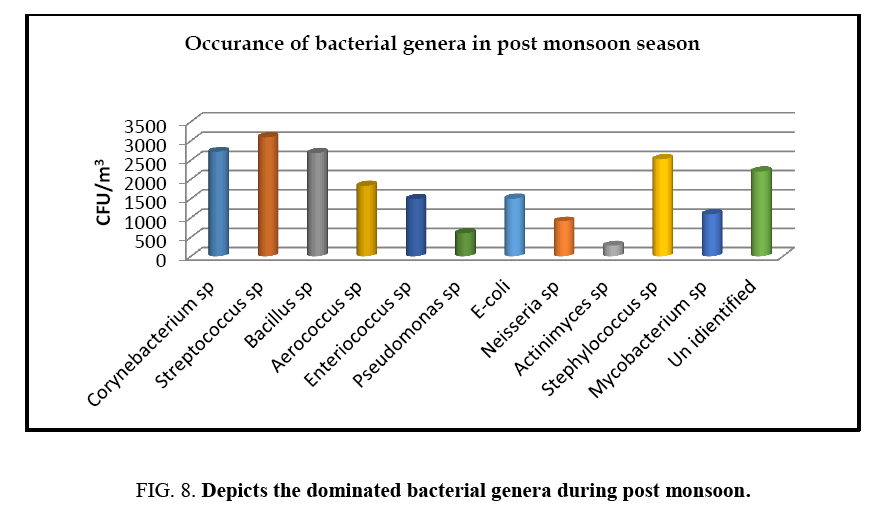Original Article
, Volume: 13( 4)Seasonal Variation of Airborne Viable Bacterial Pollution in Bengaluru Urban, Karnataka, India
- *Correspondence:
- Nandini N, Professor and Head, Department of Environmental Sciences, Bangalore University, Bengaluru, Karnataka-560056, India, Tel: +91-80- 22961367; E-mail: nandini.sai@rediffmail.com
Received: July 18, 2017; Accepted: August 05, 2017; Published: August 12, 2017
Citation: Sivasakthivel S, Nandini N. Seasonal Variation of Airborne Viable Bacterial Pollution in Bengaluru Urban, Karnataka, India. Environ Sci Ind J. 2017;13(4):145.
Abstract
Ambient viable bacterial air pollution is now recognized as an important problem worldwide. Inhalation of bacterial aerosol can cause a number of infectious disease and hypersensitivity in the lungs. Airborne diseases are most prevalent in Asian countries where India is one among them. Seasonal bacterial aerosol study was conducted to address the ambient bacterial diversity of Bengaluru urban. Bacterial aerosol was collected by impaction onto a nutrient agar medium, using a portable Mini-patrisol Anderson Air Sampler PM10 with a frequency of about thrice in a week during all season for the year 2010, 2012, 2013 and 2014. Ambient bacterial diversity assessment study showed that bacterial aerosols crossed the tolerance limit prescribed by IRSST - Guide on respiratory protection. Pre-monsoon recorded the maximum bacterial aerosols in which dominated by genera Enterococcus, Streptococcus, Pseudomonas, and E. coli where it causes urinary tract infection, bacteremia, bacterial endocarditic, diverticulitis, and meningitis. During winter genera Corynebacterium were populated. Less number of bacterial aerosols recorded during monsoon Temperature in Bengaluru urban due to regional climate change which supported pathogenic bacteria in air.
Keywords
Ambient air; Seasonal bioaerosol; Metrological parameters; Public health
Introduction
With the acceleration of urbanization and industrialization recently, the urban population result in the increase of industrial and traffic emissions are deteriorated the air quality of Indian metro cities. Biological particles in the atmosphere, often defined as bioaerosols, are airborne particles or large molecules carrying living organisms or released from living organisms (e.g., bacteria, fungi, viruses, pollen) [1]. Bioaerosols originate from almost any environmental reservoir for microorganisms, such as fresh and marine surface waters, soil, plants, bioreactors, wastes, animals and human. Bioaerosols can contribute as much as 25% to the atmospheric aerosols [2]. Studies of airborne bacterial concentrations in different surroundings have found higher concentrations in urban areas compared to rural areas and lower concentrations at coastal sites in on-shore winds [3,4]. This is largely due to characteristics of local environments. The influence of meteorology on air quality is substantial and well established, giving rise to the expectation that changes in climate are likely to alter patterns of air pollution concentrations. Weather patterns influence the movement and dispersion of all pollutants in the atmosphere through the action of winds, vertical mixing, and rainfall. Air pollution episodes can occur with atmospheric conditions that limit both vertical and horizontal dispersion. Airborne infectious disease in Bangalore urban was increased since 1980’s [5]. Little is known about the species, concentration, and distribution of airborne bacteria in Bengaluru urban. There is, therefore, a need for such systematic and detailed surveys on airborne bacteria in different season of outdoor environments. The objective of the study to describe the group of airborne bacteria present in outdoor environment and distribution pattern in ambient air. We believe that this study may provide first kind of knowledge of airborne bacterial pollution in Bengaluru at different season.
Materials and Methods
Study area and sampling location
The aerobiological study was carried out at the Department of Environmental Science, Bangalore University, Jnanabharathi campus, National Air Quality Monitoring Program station code -583, CPCB (77°30′ E and 12?50’ N) Karnataka with average Altitude of 920 m (3,018 ft). The area chosen for this investigation within fifteen kilometers from the center of the city.
Bangalore University is located in the Garden City of Bangalore aptly hailed as the “I.T. Capital of India”, was established in July 1964. Jnanabharathi campus of Bangalore University is situated in south western part of Bengaluru city which receives maximum wind from south east and from north east part of Bangalore urban. Therefore, this station is an ideal site for air pollution monitoring (Figure 1).
Figure 1: A. Bengaluru urban district, B. Department of Environmental Science, Bangalore University, C. Automatic weather station at Jnanabharathi campus of Bangalore University
Preparation of solid media for bacterial aerosol
Nutrient agar media (M001, HiMedia laboratories, Mumbai) was used for cultivation of a wide variety of bacterial aerosol. Suspended 28.0 g in 1000 ml distilled water and boiled to dissolve the medium completely and sterilized by autoclaving at 121°C, 15 lbs pressure for 15 min. Approximately, 10 ml of nutrient agar was cooled at 40°C and poured into sterilized petri dishes (80 × 17 mm) in aseptic condition. After solidification, all the plates were sealed with transparent adhesive tape (sellotape), refrigerated for further analysis. Similarly, selective isolation media for isolation of organisms belongs to the genus Aerococcus, staphylococcus, Streptococcus, Corynobacterium, Bacillus, Enterococcus, Pseudomonas, Neisseria, Actinomyces, Mycobacterium and E. coli species were prepared according to direction as per the manufacturer manual of HiMedia laboratory, Mumbai, India.
Sampling of bacterial aerosol
Air samples were collected using single stage impactor (Air petri sampling system Mark III, model No. LA474, HiMedia Laboratories Pvt. Limited, Mumbai, India) operating at about 100 L/min for 1 min, with a frequency of about twice in a week during all seasons (January to December) placing at about 1.5 m above the surface, to simulate the human breathing zone. Sampling has been carried out for all the seasons during day light hours, usually between 06.00 h and 18.00 h.
The impactor was disinfected with 99% ethanol swabs before sampling and every change of sampled plates. After sampling of fungal and bacterial aerosol, the sampled petri dishes were sealed with transparent adhesive tape (sellotape) and marked the date and time of sampling. Bacterial plates were incubated at 37°C and colonies were counted after 24 h and 48 h.
Sampling frequency
Sampling was carried out twice in a week (6.00 AM to 18.00 PM, 12 h) generated 15 samples/months for all seasons for the year 2010, 2011, 2012 and 2013. Monthly average was calculated for statistical convenient.
Enumeration bacterial organisms
Standard plate count (viable count): Enumerations of bacterial organisms were done following APHA [6]. A viable cell is defined as a cell which is able to divide and form a population (or colony). A viable cell count was done by Digital microbial colony counter (Model DCC100, Optoprecision service, Bangalore). Chains and clumps of cells were avoided to ensure the accurate determination of total viable cells. Total numbers of viable cells are reported as colony forming units (CFUs). Estimation of microbial numbers by CFU assumes that every colony is separate and founded by a single viable microbial cell [7]. Colony forming unit (CFU) is a rough estimate of the number of viable bacterial cells in a sample. The population of bacterial aerosol in air was calculated by following formula,

Identification of bacterial aerosol: Bacterial aerosol was identified based on their colony characteristics such as colour, shape, other morphological features and by performing Gram’s staining and confirmed by carrying out characteristic Biochemical tests prescribed by following standard methods of Cowan’s and Steel [8], APHA [6], Bergey’s manual of Systematic bacteriology [9].
Result and Discussion
Ambient bacterial diversity in Bengaluru Urban
Air borne bacterial population was monitored during the year 2010, 2011, 2012 and 2013. The sampling was performed for two days in a week from 6.00 AM to 6.00 PM for all the seasons of the year.
The average bacterial aerosol recorded during the year 2010 as 27,209 CFU/m3, for the year 2011 as 37, 435 CFU/m3, for the year 2012 as 37, 795 CFU/m3 and for the year 2013 was recorded as 43,009 CFU/m3 (Figure 2). Maximum was recorded during the month of January and minimum was during the month of April. Maximum bacterial aerosol was recorded during the year of 2012 attributed by dumping of municipal solid waste (MSW) around the city. Field observations have shown that municipal waste in the Bengaluru city was not managed properly (Figure 3).
In proper waste collection at house hold level, lack of perception on solid waste management and lack of coordination of localities and Bengaluru city municipal authority resulted dumping of solid waste around the study area. Organic and inorganic waste in ventilated place around the study area might have influenced the dispersion of bioaerosol [10]. In Bangalore urban generate a great amount of municipal solid waste which is dumped on land in uncontrolled manner. Accumulation of solid waste in unscientific way leads to leachate formation that contains a large number of xenobiotic organic compounds and contaminates the air. Soil and surface and ground waters in the vicinity of the site. Pathogens found in MSW, can be viruses, bacteria, protozoa or helminths [11].
The research results reveal that bacterial aerosol for the year of 2010, 2011, 2012 and 2013 crossed the tolerance limit of 10,000 CFU/m3 prescribed by the Institut de recherché Robert-Sauvé en santé et en sécurité du travail, Occupational Health and Safety Research Institute Robert-Sauvé [12].
Seasonal variability of bacterial aerosol
Seasonal variation of bacterial aerosols depends on meteorological parameters such as temperature, relative humidity and rainfall. Population and genus of bacterial aerosols changed with the time of the day, weather conditions, season, geographical location, and the presence of sources.
The experimental data of Bacterial aerosol for the period of 2010 to 2013 are compiled and classified season wise to reveal the variability of bacterial aerosol during different seasons of Bengaluru. The seasons are classified according to Indian Meteorological organization (IMO). The season are i. winter (December, January, and February); ii. Pre-monsoon or summer (March, April, and May); iii. Monsoon (June, July, and August); iv. Post monsoon (September, October, and November).
A. Pre-monsoon (Summer)
Pre-monsoon earned the first place in Bacterial aerosol number with an average population of 62,827 CFU/m3 (Figure 4). Maximum population of bacterial genera like Streptococcus found to be 9,895 CFU/m3, Bacillus was 6,193 CFU/m3, Staphylococcus and Escherichia coli was recorded as 5,392 CFU/m3 and 4,711 CFU/m3 during pre-monsoon season (Figure 5).
B. Winter season
The winter season earned the second place in bacterial aerosol number with an average population of 37,276 CFU/m3 (Figure 4). Maximum population of bacterial genera like Corynebacterium, Streptococcus, Bacillus and Staphylococcus populated during winter (Figure 6).
C. Monsoon
Occurrence of bacterial aerosol was decreased during monsoon. The average bacterial aerosol number during monsoon was recorded as 24,477 CFU/m3 (Figure 4). However, Considerable number bacterial genera like Streptococcus, Enterococcus and E. coli species were recorded during monsoon (Figure 7).
Figure 7: Depicts the dominated fungal genera during monsoon.
D. Post monsoon
The average number of bacterial aerosol was 33,011 CFU/m3 (Figure 4). Higher number of bacterial genera like Streptococcus, Staphylococcus and Bacillus was recorded during post monsoon (Figure 8).
The result revealed that maximum number of bacterial aerosol were recorded during pre-monsoon (summer) season and minimum during monsoon. In pre-monsoon season, bacterial genera like Streptococcus, Bacillus, Staphylococcus and Escherichia sp., dominated. This bacterial pollution during pre-monsoon season is health risk of food poisoning and gastrointestinal disease. Staphylococci are the third most common causes of nosocomial infections and the most common causes of nosocomial bacteria. Streptococci species normally present in the human respiratory tract, they also have been implicated as the cause of infective endocarditis and life-threatening septicemias in neutropenic patients. In addition, Streptococci have been implicated as reservoirs of erythromycin-resistance genes, possibly capable of transferring resistance determinants to more pathogenic species including Streptococcus pneumonia and Streptococcus pyogenes [13]. These bacterial aerosols might have originated from contaminated soil, sewage treatment plant, open sewage drainage and unscientific garbage disposal in Bengaluru urban. Dispersion of bioaerosol at source is driven by climatic condition and geographical location.
Similar findings were recorded by Lee et al. [14] found that hot weather conditions during summer season and winter season result in environmental distinctions for dispersion of bioaerosols. Ian Colbeck and Zaheer Ahmad Nasir [15] reported in their study found that outdoor bioaerosol concentrations were more in summer than in winter seasons. Viable bioaerosol concentrations were significantly higher in summer than winter and spring. Predomination of bacterial aerosol in summer attributed by various factors like favorable temperature, nutrient availability in the atmosphere. Most of the bacteria genera were isolated in Bengaluru urban are mesophilic which grow best at 30°C to 37°C. Optimum temperature for growth of common pathogenic bacteria is 37°C. Optimum temperature during summer enhanced the survival and multiplication of bacterial aerosol in air. Similar findings were reported by Lee and Jo [16] that total number of bio-aerosols detected during summer was more than other seasons.
The declined state of bacterial aerosol may be due to frequent rainfall during monsoon. In monsoon season, bacterial genera like Streptococcus, E. coli and Enterococcus sp., dominated where it causes urinary tract infection, bacteremia, bacterial endocarditis, diverticulitis, and meningitis. Similar findings were recorded by Shah et al. [17] who states that minimum population of air microbes were observed during monsoon season compared to winter and summer seasons. This may be due to maximum settling of aerosols and soil particles on the ground. In post monsoon season bacterial genera like Streptococcus, Staphylococcus and Bacillus dominated which are allergenic to human and infects the skin.
Influence of meteorological parameters on bacterial aerosol
Meteorological parameters recorded during different season and Karl Pearson rank correlation were used to evaluate the association of bacterial aerosol dispersion with temperature, Relative humidity, rainfall, wind speed, wind direction. The correlation between bioaerosol and meteorological parameters revealed that meteorological parameters have significant impact on bacterial aerosol.
Temperature and relative humidity
Temperature and relative humidity data were recorded simultaneously during the study. The temperature record from 2010 to 2013 shows that there is a mild increasing tendency of temperature in Bangalore weather. Minimum annual mean of 29.12°C were recorded in 2011 and maximum annual mean of 29.77°C was recorded in 2013. Similarly, highest percentage of relative humidity was recorded in 2010. Annual mean as 70.32. Minimum percentage of relative humidity was recorded in 2012, the annual mean as 63.1.
Correlation analysis of bacterial aerosol on temperature and relative humidity showed that bacterial aerosol had strong correlation with temperature than relative humidity. Bacterial aerosols during all the seasons showed positive correlation with temperature. High correlation rate was found during pre-monsoon as r=0.369 which indicates that temperature in summer favor the bacterial aerosols. The correlation rate in monsoon is r=0.013, post monsoon is r=0.010 and winter is r=0.116. But, Relative humidity showed least correlation with bacterial aerosol during all seasons. Spearman’s rank correlation result provides baseline information that temperature in summer (pre-monsoon) favors the growth of bacterial aerosol. Bacterial spores are known to exhibit high biological stability within a wide range of temperatures, and it has been assumed that the spores will also remain viable when airborne under high temperature. Many investigations conducted by Li et al. [18] confirmed that climatic conditions during summer are favorable for the survival and proliferation of airborne bacterial organism within the temperature range of 29°C to 49°C.
Conclusion
Ambient bacterial diversity was assessed in Bengaluru urban proved that bacterial aerosols crossed the tolerance limit prescribed by IRSST - Guide on respiratory protection against bioaerosols [12]. Bacterial aerosols were dominated during summer which is health risk of infectious disease. Seasonal variation of bacterial is governed by meteorological parameters of Bengaluru urban. Temperature records for the study period showed that annual ambient temperature in Bengaluru is slightly increased due to regional climate change which supported pathogenic bacteria in air.
Acknowledgment
The authors acknowledge the Central Pollution Control Board (CPCB), New Delhi, Government of India, New Delhi and Karnataka State Pollution Control Board (KSPCB), Government of Karnataka for providing infrastructure and financial assistance which buttressed the work comfortably.
References
- Ariyap A, Amyot M. New directions: The role of bioaerosols in atmospheric chemistry and physics. Atmos Environ. 2004;38(8):1231-2.
- Jaenicke R. Abundance of cellular material and proteins in the atmosphere. Science.2005;308(5718):73.
- Bovallius A,Bucht B, Roffey R, et al. Three-year investigation of the natural airborne bacterial flora at four localities in Sweden. Appl Environ Microbiol.1978;35:847-52.
- Shaffer BT, Lighthart B. Survey of culturable airborne bacteria at four diverse locations in Oregon: Urban, Rural, Forest, and Coastal. Microb Ecol.1997;34:167-77.
- Paramesh H. Effect of urbanization, air pollution on health. 2nd International Conference on Environment and Health, Bangalore, India. 2000.
- American Public Health Association. Control of Communicable Diseases Manual. 19thed. In: Heymann DL, editor.Washington, D.C.: APHA Press, USA; 2008. 746 p.
- Goldman E, Green LH. Practical Handbook of Microbiology. 2nded. Boca Raton: CRC Press, Taylor and Francis Group, USA; 2008.
- Cowan and Steel. Manual for the identification of medical bacteria. 3rded. In: BarrowGI, FelthamRKA. Cambridge: Cambridge Publication, UK;2003.
- Bergy’sManual of Systematic Bacteriology. 2nd ed.Berlin: Springer publication, Germany; 2009.
- Sivasakthivel S, Nandini N. Seasonal distribution of ambient fungal spores in Bengaluru Urban, Karnataka, India.Int J Sci Res SciEng Technol.2015;1(4):271-82.
- Xu YP, Zhou YQ, Wang DH, et al. Occurrence and removal of organic micropollutants in the treatment of landfill leachate by combined anaerobic-membrane bioreactor technology. J Environ Sci.2008;20(11):1281-7.
- Robert-Sauvé Research Institute for Occupational Health and Safety. IRSST - Guide on respiratory protection against bioaerosols. 2007.
- Bryskier A. Viridans group Streptococci:A reservoir of resistant bacteria in oral cavities. ClinMicrobiol Infect 2002;8(2):65-9.
- Leel BU, Hong IG, Lee DH, et al. Bacterial bioaerosol concentrations in public restroom environments. Aerosol Air Qual Res.2012;12:251-5.
- Ian C&Zaheer AN. Human exposure of pollutants via dermal absorption and inhalation. In: Lazaridi M, Colbeck I, editors.Berlin: Springer publication, Germany; 2010.
- Lee JH, Jo WK. Characteristics of indoor and outdoor bioaerosols at Korean high-rise apartment buildings. Environ Res. 2006;101(1):11-7.
- Shah SQA, Colquhoun DJ, Nikuli HL et al. Prevalence of antibiotic resistance genes in the bacterial flora of integrated fish farming environments of Pakistan and Tanzania. Environ Sci Technol. 2012;46(16):8672-9.
- Li Y, Fu H, Wang W, et al. Characteristics of bacterial and fungal aerosols during the autumn haze days in Xi'an, China. Atmos Environ.2015;122:439-47.
